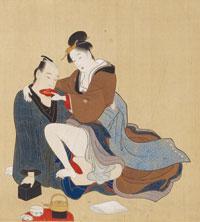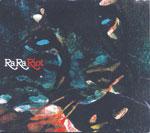Arts Review

Painting from “Drama and Desire” at the MFA.
September 18, 2007
Long ago in the Japanese city of Edo (now the technological metropolis and capital of Tokyo) there was a magical place known as the “floating world.” This was a place where men of a specific social class could go to find gratification. Here, in the theaters and “pleasure quarters” men could find the cultural sophistication of kabuki, as well as the sexual decadence of geisha houses and high-class brothels. From within this sensuous world emerged the Ukiyo-e style of painting, a derivation of the more well-known woodblock printing. Ukiyo-e served as an opportunity for the artists of the woodblock technique to explore the same subjects in a more personal medium. Now, through Dec. 16, the Museum of Fine Arts – Boston will be featuring “Drama and Desire: Japanese paintings from the Floating World 1690-1850,” an exhibition that offers a rare glimpse into paintings of these ukiyo-e masters.
The exhibition features 83 of the museum’s collection of 700 ukiyo-e paintings and derives its name from the “drama” and “desire” depicted in its most magnificent pieces, two six-panel folding screens by Hishikawa Moronobu, Scenes from the Nakamura Kabuki Theater and Scenes from the Yoshiwara Pleasure Quarter. These works are the cornerstones of the exhibit, each an exquisite example of the very essence of drama and desire distilled into the simplistic elegance of ukiyo-e painting. The screens, scrolls, banners, and signboards that make up the exhibit offer a brief glimpse into the softer side of a harsh, male dominated society.
The exhibit is broken down into five sections. Early Ukiyo-e from1690-1765 is where the viewer finds the Moronobu screens as well as a handful of signboards-brightly colored advertisements for the kabuki plays of the time. In “An Air of Innocence” from 1765-1780, Suzuki Harunobu and his contemporaries created works meant as parodies, with well-known images of Buddhist figures replaced with characters from within that “floating world.” The next two sections, “Images of Feminine Allure,” Torii Kiyonaga and Kitagawa Utamaro’s work from 1780-1805, and Utagawa School, 1780-1850, show the progression towards a more realistic female form, seen in the eroticism of shunga, or “spring pictures.” The final section, “Katsushika Hokusai: The Man Mad about Painting,” features the work of the prolific master of the ukiyo-e form. Hokusai explores everything from Mt. Fuji to the sensuality of the female body. Throughout the exhibit one will find a handful of examples of shunga, or “spring pictures.” Shunga is a form of erotic Japanese art that is rarely seen today because of censorship laws and societal sensibility.
“Drama and Desire: Japanese Paintings from the Floating World 1690-1850” is a walk through a land that is long since gone. It’s a trip to a world of sophisticated pleasure that has been swallowed up by the fast-paced ferocity of the modern world. Even in a place so steeped in tradition and spirituality as Japan, a world like Edo and the relaxing aura of its theaters and “pleasure quarters” is but a far distant memory, a world found only in the past.
The Museum of Fine Arts-Boston is located at 465 Huntington Ave. Information about this exhibit and others can be found at the MFA’s website. www.mfa.org

























































